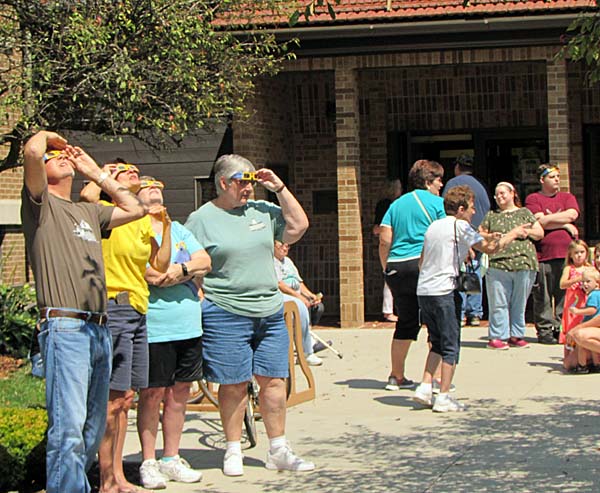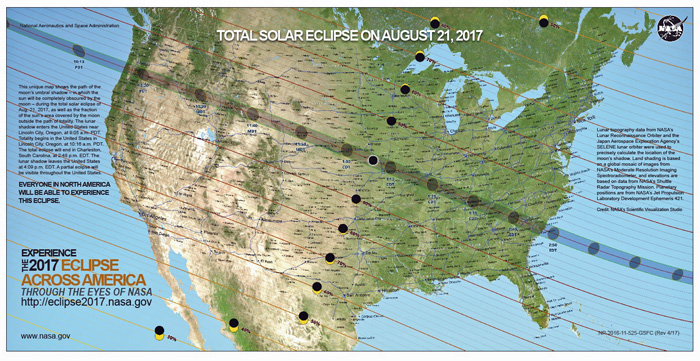Pulaski County to experience 88% partial solar eclipse
- Details
- Published: Sunday, 13 August 2017 00:42
A total eclipse of the sun will be visible across the continental United States on Monday, Aug. 21 - the first coast-to-coast solar eclipse in the U.S. in nearly a century.
Pulaski County will experience a partial eclipse with the peak at 2:23 p.m., when the moon will obscure 88 percent of the sun. The Pulaski County Public Library will hold an Eclipse Viewing Party between 1 and 3:30 p.m. Eclipse glasses will be provided for safe outdoor viewing. The eclipse will also be streamed live on the big screen in the library's activity room, where visitors can sit down and enjoy refreshments.

Solar eclipses occur during the new moon, when the moon is directly between the Earth and sun, causing the disk of the moon to partially or totally cover the disk of the sun. In the U.S., the path of the total eclipse will sweep from the Oregon coast at 10:17 a.m. PDT to the South Carolina coast at 2:47 p.m. EDT.
Eclipse 2017.org acknowledges that a lot of people are thinking, "wait a minute - I'm pretty sure I saw an eclipse, and it wasn't that long ago." The website explains you may very well have seen a partial or an annular eclipse. But a total eclipse is "extremely rare, extremely beautiful, and the bare-eye view of totality is absolutely unmistakable to anyone in the thin path. They are the kings of eclipses, with nothing else able to stand in comparison to it."
The last coast-to-coast total eclipse in the U.S. occured in June 1918 with a nationwide band of totality stretching from the southwest corner of Washington, through Denver, the Tulsa/OKC area, Jackson, Miss., the panhandle of Florida and Orlando.
The Washington Post reports the next total solar eclipse to be visible from planet Earth will occur in July 2019 over Argentina and Chile. And the United States is set to see another total eclipse on April 8, 2024, when the moon will cast a shadow across Mexico, Texas, Oklahoma, Arkansas, Missouri, Illinois, Kentucky, Indiana, Ohio, Pennsylvania, New York, Vermont, New Hampshire, Canada and Maine.
The Washington Post has an excellent article on "Everything You Need to Know About the Aug. 21 Solar Eclipse."
NASA TV will carry the eclipse live from coast to coast beginning at noon EDT.
 |
A scientifically significant event
Scientifically, the eclipse will provide important data to astronomers, such as those who study energy transmission in the outer layers of stars, says Caty Pilachowski, the Daniel Kirkwood Chair in the Indiana University Bloomington College of Arts and Sciences' Department of Astronomy. She is also a past president of the American Astronomical Society.
"During this eclipse, the moon will appear about 3 percent larger than the sun, which means astronomers will be able to see the flare of the sun's corona down to about 15,000 miles above the sun's brilliant disk, called the photosphere," Pilachowski said. "This event will provide a special opportunity to study the region where the corona is heated to millions of degrees Fahrenheit, as compared to the relatively 'cooler' temperatures of 10,000 degrees Fahrenheit in the sun's lower atmosphere."
A reason to look skyward
Eclipses provide a chance for modern people to re-connect with their ancient ancestors' awe of the sky, says Gregg Williams, an adjunct astronomy instructor at IU Northwest and director of the Merrillville Community Planetarium.
"Besides checking the weather, most people give only a passing glance to the sky," Williams said. "By contrast, ancient people felt a connection to the heavens since they depended on the sun and stars to tell time and mark their calendars. Many people who observe a total eclipse of the sun report experiencing a sense of awe bordering on the spiritual. This response is probably very similar to the emotions our ancient ancestors felt as they saw the sun, upon which our planet depends for light and heat, temporarily blotted from view."
A rare astronomical phenomenon
Eclipse are rare events for two reasons: the size of the moon's shadow, which is only about 70 miles wide, and the 5-degree tilt of the moon's orbit, which causes it to rarely line up between the sun and the Earth, says Patrick Motl, an associate professor of physics and associate dean in the School of Science at IU Kokomo. He is also director of the IU Kokomo Observatory.
"On average, any given spot on Earth will only see a total solar eclipse every 375 years, creating a small but loyal community of 'eclipse-watchers' who travel the world to chase the phenomenon," Motl said. "The last total solar eclipse in the U.S., which was only visible in parts of the Pacific Northwest, took place in 1979. A coast-to-coast eclipse hasn't occurred in the U.S. since June 1918."
Eclipses are also a chance to reflect upon humanity's progress, Motl said, noting that some of the first people to predict eclipse were ancient Mayans, who took measurements over hundreds of years. Later, eclipses helped confirm Einstein's theory of relativity by revealing that the position of stars shifts slightly as their light passed by the Sun due to the bending of space time.
Eye safety during the eclipse
Because Indiana will only experience a near-total eclipse of the sun, as opposed to a full eclipse, IU School of Optometry professor Arthur Bradley says. it's crucial people are aware of the dangers of looking at the sun without protection.
"The only safe way to view a partial solar eclipse is using special solar filters, such as 'eclipse glasses,' or hand-held solar viewers," Bradley said. "Looking at the sun without proper equipment will damage the fovea, the most important part of the retina. Often people aren't even aware of the damage since the retina lacks pain receptors."
To safely view the eclipse, Bradley recommends using a solar viewer from one of five manufacturers found to meet international eye safety standards by the American Astronomical Society. He also warns that no one should ever attempt to view an eclipse using sunglasses.
Aug. 21 Solar Eclipse creating tourism boom
WEST LAFAYETTE - Tourists are planning trips to get the best possible views of the Aug. 21 solar eclipse. Jonathon Day, Purdue University associate professor in hospitality and tourism management, says tourists should embrace the eclipse and their viewing destination.
Travelers are expected to flock to areas from Oregon to South Carolina to see the rare celestial event. The largest city in the eclipse path is Nashville, Tennessee, where tourism officials expect 50,000-70,000 visitors.
Day said people should have fun with the show in the sky. “Eclipses are pretty special phenomenon, and people have been chasing eclipses for hundreds of years,” he said. “Take the time to explore the locations you visit to see the eclipse. It will be a fun and unique part of the summer of 2017. But while there, check out the fun and interesting things that local communities are doing to attract eclipse visitors.”







